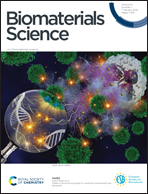Injectable thioketal-containing hydrogel dressing accelerates skin wound healing with the incorporation of reactive oxygen species scavenging and growth factor release†
Abstract
Wound healing is a complex dynamic process. During the occurrence of skin injury, the excessive reactive oxygen species (ROS) level is associated with sustained inflammatory response, which limits efficient wound repair. Although multifunctional hydrogels are considered ideal wound dressings due to their unique advantages, the development of hydrogel dressings with rapid gelling rates, shape adaptation, and antioxidant function is still a vital challenge. In this work, a ROS-responsive injectable polyethylene glycol hydrogel containing thioketal bonds (PEG-TK hydrogel) was synthesized and utilized to deliver epidermal growth factor (EGF). We adopted bio-orthogonal click chemistry for crosslinking the polymer chains to obtain the EGF@PEG-TK hydrogel with fast gelation time, injectability and shape-adaptability. More interestingly, the thioketal bonds in the PEG-TK hydrogel not only scavenged excessive ROS in the wound sites but also achieved responsive and controlled EGF release to facilitate regeneration. The EGF@PEG-TK hydrogel treatment offered the benefits of protecting cells from oxidative stress, accelerating wound closure, and reducing scar formation in the full-thickness skin defect model. This work provides a promising strategy for developing antioxidant hydrogel dressing for facilitating the repair of wounds.



 Please wait while we load your content...
Please wait while we load your content...